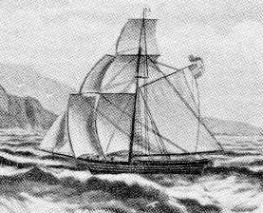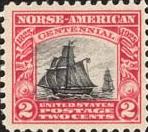On the first leg of its journey, Restauration sailed southwest to the English Channel, a distance of 530 nautical miles, then skirted the entire south coast of England for 260 miles and anchored in a harbor called Lizard Head in Cornwall. This was to be the last land for some time and they had to lay in a fresh supply of water. While this was being done, some of the party began exchanging brandy carried on board for provisions supplied by the local inhabitants, not knowing this was in violation of the English liquor laws. The officials were about to arrest the captain and crew when the crew suddenly discovered their danger and quickly set sail for the open sea.
From Cornwall the course set by the captain was southwest by south
past the coast of Spain and Portugal. After a voyage of 1280
miles, the sloop approached the However, trouble threatened from quite another source. Due to their sudden departure on jump ahead of the law in England, the Sloopers were nearly out of food and water when they arrived off Madeira. A cask was spotted floating on the waves, and they lost no time in lowering a yawl to get it to see what it contained. One Slooper almost lost his hand when attacked by a shark while he was attempting to tie a rope around the middle of the cask. Out of the water the cask was found to be completely covered by barnacles, indicating it had been in the sea for a long time. Upon opening it they found it contained a very delicious wine, which most of the crew and some of the passengers immediately indulged in. By the time the ship drifted into the harbor of Funchal, it was without colors and apparently without command. The harbor patrol feared the sloop was a plague ship with the crew dead or dying and that a disease was being brought into the city. A German ship was anchored nearby and having seen that the cannon of the harbor fortress were already aimed at the strange vessel, they called across the water, "Hoist flag! Hoist flag!" This alerted the Sloopers to their danger, and they quickly searched for the Norwegian flag which had been stowed somewhere with other baggage. One of the women passengers stood up on the prow and, disregarding the immodest display of her legs, waved her bright calico skirt to prevent the cannon from being fired. Another passenger finally found the flag and, with help, ran it to the top of the mast. The Portuguese customs officers came on board and found things in good order. The Sloopers arrived in Madeira on August 1. They were about 2070 sea miles out from Stavanger and had spent 27 days on the water, an average of 77 miles a day. The Madeirans were kind and hospitable and the American Consul entertained the entire company of 52 people at a magnificent dinner, which was greatly appreciated. They increased their provisions and sailed out of Madeira on August 7. The trade winds carried them far south of the Tropic of Cancer, then northward in the direction of the West Indies. The going was rough, especially when it stormed. The little ship would rock violently from side to side or pitch upward and then plunge down into the deep. The sea would hit it so hard it would shudder and the beams and blanks would groan. There were no comforts - no private places to go. They were packed in like sardines, especially during stormy weather when they had to remain below, and there were no fans or portholes to blow out the smells produced by seasickness. On such days those who were able to eat dined on flatbrød and dried fish, because the galley on deck could not be used. It was probable that religious meetings were held on board when the weather permitted. My great-great-grandfather, Ole Olsen Hettleviet, who was 28 at the time, was presumed to be one of the leaders because of his later religious work. The most important personal event of the voyage was the birth of a baby girl on September 2, when the sloop was near the West Indies. The Restauration continued the wide southwesterly arc of its course and swung northward near the West Indies. It fell into the Gulf Stream, and as September wore on, it went up along the continental shelf to Long Island. Rounding the eastern end, the sloop sailed down Long Island Sound. We have no accurate record here, and it seems odd that a vessel from southern waters should go around Long Island. It was either driven off course or the captain's knowledge of these waters was inadequate. Finally, on Sunday, October 9, 1825, 64 days after leaving Madeira and 98 days out from Norway, the Sloopers entered New York harbor. But they were not out of trouble. There had been a law passed in 1819 that they knew nothing about, stating that all ships entering the country must carry no more than two passengers for every five tons of the ship's weight. The fine for excess passengers was $150 each. The Restauration weighed less than 30 tons and should have carried not more than 16 passengers. The customs officials were sympathetic, though, and reckoned the ship's weight to be 60 tons, which would accommodate 24 passengers. This still left 21 passengers to pay a fine of $3,150, which they did not have. The crew was not considered to be passengers.
On October 13 the Sloop was seized and the captain jailed. The
Quakers in New The passengers had gone on ahead, traveling by steamboat, something very new then, up the Hudson River, Erie Canal, across New York to Buffalo. They were on the Erie Canal when it officially opened, October 26, 1825. Departing the canal west of Rochester, they traveled north through the woods about nine miles to the shore of Lake Ontario. This was their first settlement, the Kendall Colony or Murray, as it was also called. My great-great grandfather traveled from there to Niagara Falls where he met and married Sara Porter Chamberlain, a cousin of the wife of Daniel Webster. Their first child, Bertha Ann, who was my great-grandmother, was born there. Six families moved from the Kendall Colony in 1834 to the Fox River Settlement in Illinois. This is now named Norway. It is presumed that Ole Olsen followed them, as the book says he was living in Illinois in 1850. Ole Olson was the first Norwegian lay preacher in America. He traveled around selling Bibles and holding services. He conducted the first Norwegian Lutheran service held in the Mississippi Valley. He is known to have preached in the Old Muskego Church, the first Norwegian Lutheran Church in the United States, which was build in 1844 in Wind Lake, Wisconsin, and is now preserved on the Luther College campus in St. Paul. He died January 27, 1854, at the age of 57, and is buried in the Millington Cemetery, Kendall County, Illinois.
This is the second half of the story and is from the book, The Sloopers, Their Ancestry and Posterity, written by J. Hart Rosdail, a descendant of a Slooper. |
 Madeira
Islands, only 300 miles off the northwest coast of Africa. This
southern detour was made to take advantage of the eastern trade winds
which blew from there westward. Captain Helland was equipped with
signal communicate with any Swedish ships he might find in African
waters, but he lacked a pass for protection against Barbary pirates.
Madeira
Islands, only 300 miles off the northwest coast of Africa. This
southern detour was made to take advantage of the eastern trade winds
which blew from there westward. Captain Helland was equipped with
signal communicate with any Swedish ships he might find in African
waters, but he lacked a pass for protection against Barbary pirates. York came to their rescue and raised a $600 bond to get the captain
released from jail. The Sloopers petitioned the court because of
their ignorance of the law, and on November 15 a formal Proclamation of
Pardon was drawn up and signed by John Quincy Adams, the 6th President
of the United States, which released the Restauration to the owners so
it could be sold to pay the fine.
York came to their rescue and raised a $600 bond to get the captain
released from jail. The Sloopers petitioned the court because of
their ignorance of the law, and on November 15 a formal Proclamation of
Pardon was drawn up and signed by John Quincy Adams, the 6th President
of the United States, which released the Restauration to the owners so
it could be sold to pay the fine.